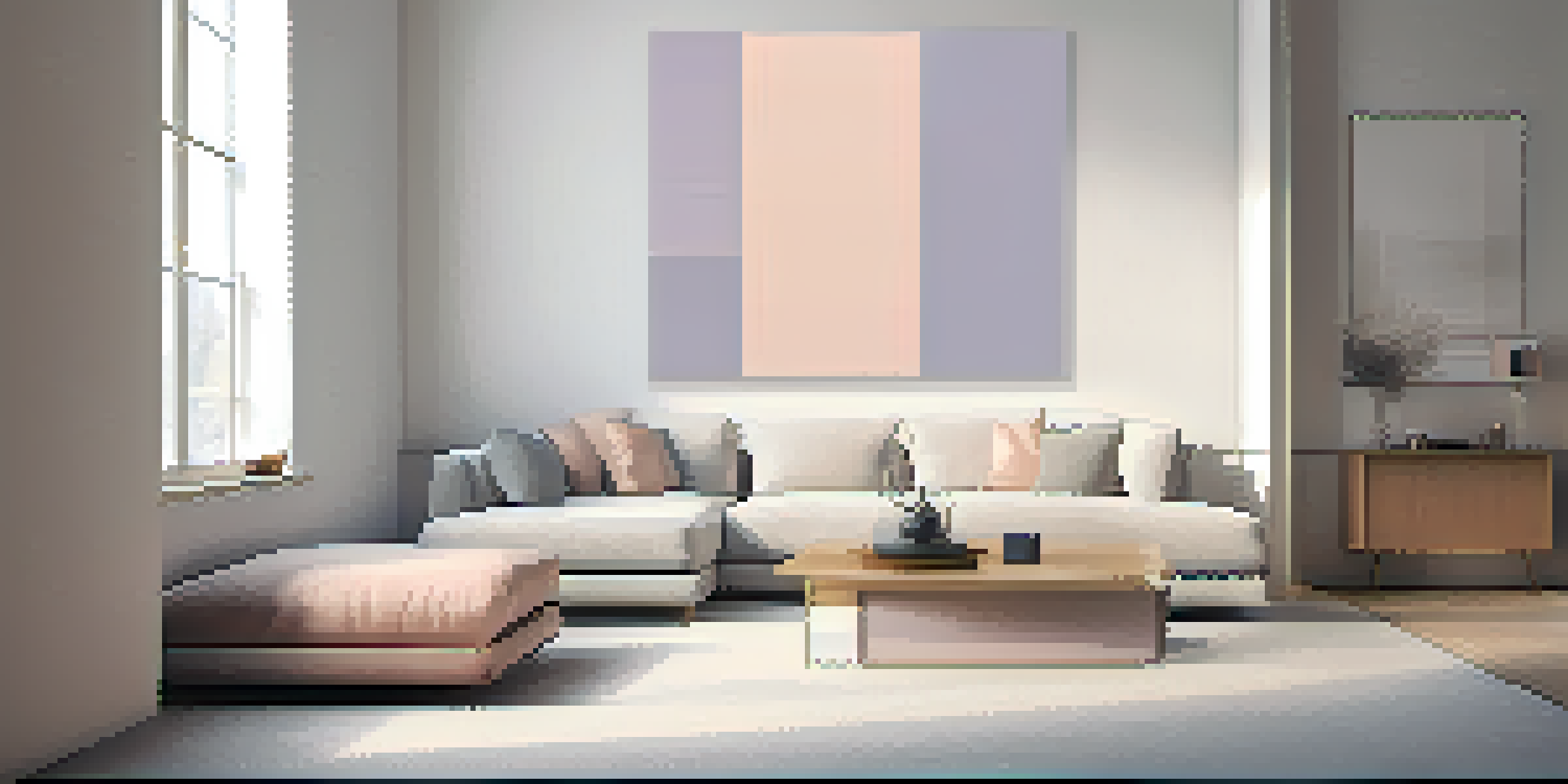Exploring the Aesthetic of Minimalism in Modern Paintings

Understanding Minimalism: A Brief Overview
Minimalism, as an art movement, emerged in the late 1950s and emphasizes simplicity, focusing on the essence of the subject. Instead of overwhelming viewers with complexity, minimalist art strips away unnecessary elements, inviting a more profound engagement with the artwork. This approach can be likened to decluttering your home; just as a tidy space can create peace of mind, minimalism in art fosters clarity and thoughtfulness.
Simplicity is the ultimate sophistication.
Artists like Donald Judd and Agnes Martin paved the way for this movement, showcasing how less can truly be more. Their works often feature geometric shapes and subtle color palettes, drawing attention to the materials used and the space around them. By focusing on these fundamental aspects, minimalism encourages viewers to pause and reflect, creating an intimate dialogue between the art and its audience.
In modern paintings, minimalism continues to thrive, evolving while staying true to its core principles. Color, form, and space are manipulated to evoke emotion without the clutter of excessive detail. As we explore modern minimalist paintings, we uncover a world where simplicity reigns and complexity is found in the subtlety.
Key Characteristics of Minimalist Paintings
Minimalist paintings often exhibit a few distinct characteristics that set them apart from other art styles. One key feature is the limited color palette, which can range from monochromatic shades to soft pastels. This intentional choice allows the viewer to focus on the interplay of shapes and forms, rather than being distracted by vibrant colors.

Another defining trait is the use of geometric shapes and clean lines. These elements are deliberately arranged, creating a sense of balance and harmony in the composition. Think of it like a well-composed piece of music, where each note plays a crucial role in achieving the desired emotional impact.
Minimalism Emphasizes Simplicity
By stripping away unnecessary elements, minimalist art fosters clarity and invites deeper engagement with the viewer.
Finally, the use of negative space is a hallmark of minimalist paintings. This 'empty' space is just as significant as the painted areas, as it serves to enhance the overall aesthetic. By allowing for breathing room within the artwork, minimalist artists invite viewers to engage more deeply, prompting personal interpretation and reflection.
The Emotional Impact of Minimalism
At first glance, minimalist paintings may seem devoid of emotion, but they often evoke powerful feelings through their simplicity. The sparse use of elements can create a sense of tranquility, allowing viewers to connect with their own thoughts and emotions. Imagine standing in a quiet room, where the absence of noise allows you to hear your own heartbeat; minimalist art can evoke that same introspection.
Less is more.
Moreover, the emotional impact of minimalism lies in its ability to highlight the viewer's experience. Each person's interpretation can vary significantly based on their own backgrounds and feelings, making minimalist art a personal journey. For instance, a simple blue canvas might evoke calmness for one person while triggering memories for another.
This unique connection fosters a deeper appreciation for the artwork, as it encourages individuals to explore their own emotions. In a world filled with distractions, the emotional resonance found in minimalist paintings provides a refreshing escape and a chance for self-discovery.
Notable Minimalist Artists and Their Works
Several artists have left an indelible mark on the minimalist movement, each contributing unique perspectives and styles. One prominent figure is Ellsworth Kelly, known for his bold use of color and form. His works, often featuring large, flat planes of color, challenge viewers to appreciate the beauty of simplicity and abstraction.
Another notable artist is Frank Stella, whose work often combines geometric shapes with vibrant colors. Stella's pieces invite viewers to consider the relationship between the artwork and its surroundings, emphasizing the importance of spatial awareness. Like a well-structured poem, his art conveys meaning through form and arrangement.
Negative Space Enhances Experience
The use of negative space in minimalist paintings creates balance and encourages viewers to actively interpret the artwork.
Lastly, the work of Yayoi Kusama exemplifies how minimalism can intersect with other artistic movements. Her iconic polka dots and infinity rooms create immersive experiences that blur the lines between minimalism and maximalism. This fusion encourages viewers to explore their own perceptions of space, inviting them into a world that challenges traditional definitions of art.
The Role of Negative Space in Minimalism
Negative space plays a crucial role in minimalist paintings, often serving as a silent partner to the painted elements. This space is not merely empty; it has a purpose, guiding the viewer's eye and creating a sense of balance within the composition. Think of negative space as the pauses in music, which can enhance the melody and create a more profound experience.
By incorporating negative space, artists encourage viewers to engage more actively with the artwork. Instead of simply observing, individuals are invited to explore the relationship between the painted elements and their surroundings. This interaction can lead to a more enriching experience, as one contemplates how the space affects their perception of the work.
Additionally, negative space can evoke a sense of calmness and reflection. In a world full of chaos, minimalist paintings that emphasize this aspect provide a sanctuary for the mind. As viewers absorb the art, they may find themselves in a meditative state, allowing for a deeper appreciation of both the artwork and their own thoughts.
How Minimalism Influences Contemporary Art
The principles of minimalism have significantly influenced contemporary art, inspiring a new generation of artists to explore simplicity and abstraction. As artists seek to convey complex ideas in a straightforward manner, many have adopted minimalist techniques to enhance their work. This trend can be seen in various mediums, from painting and sculpture to digital art.
For instance, the rise of digital art has allowed artists to experiment with minimalist aesthetics in innovative ways. The clean lines and simplified forms often found in digital pieces echo traditional minimalist principles, demonstrating that the movement continues to evolve. Similarly, installations and mixed media projects often incorporate minimalist elements, creating immersive experiences that draw upon the viewer's engagement with space and form.
Minimalism's Modern Influence
The principles of minimalism continue to shape contemporary art and design, reflecting a broader cultural shift towards simplicity.
Moreover, the influence of minimalism can be observed in the design world, where simplicity is often synonymous with sophistication. From architecture to product design, the minimalist ethos prioritizes functionality and elegance, reflecting a broader cultural shift towards minimalism in everyday life. As artists and designers continue to explore this aesthetic, the legacy of minimalism remains vibrant and relevant.
Conclusion: The Lasting Appeal of Minimalism
The aesthetic of minimalism in modern paintings continues to captivate audiences, inviting them to embark on a journey of self-discovery and reflection. By stripping away the unnecessary, artists create works that resonate on a deeply personal level, allowing viewers to engage with their emotions and thoughts. This timeless appeal underscores the power of simplicity in art.
As we navigate a world filled with distractions and complexities, minimalist art offers a refreshing perspective, reminding us of the beauty found in simplicity. The ability to evoke profound feelings through a limited palette or geometric forms showcases the depth of thought and intention behind each piece. Like a gentle breeze, minimalist paintings can stir emotions without overwhelming the senses.

In exploring the aesthetic of minimalism, we are reminded that art is not just about what we see, but also about what we feel. The ongoing relevance of minimalism in modern paintings serves as a testament to its enduring impact, inspiring both artists and audiences to embrace simplicity in their own lives.